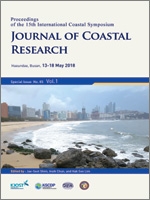Verduzco-Zapata, M.G.; Olivos-Ortiz, A.; Liñán-Cabello, M.; Ortega-Ortiz, C.; Galicia-Pérez, M.; Matthews, C., and Cervantes-Rosas, O., 2018. Development of a Desalination System Driven by Low Energy Ocean Surface In: Shim, J.-S.; Chun, I., and Lim, H.S. (eds.), Proceedings from the International Coastal Symposium (ICS) 2018 (Busan, Republic of Korea). Journal of Coastal Research, Special Issue No. 85, pp. 1321–1325. Coconut Creek (Florida), ISSN 0749-0208.
As an effort to mitigate the water scarcity and to achieve a water security status in remote coastal communities with few or no hydraulic systems, or in places with compromised services due to natural disasters, a new semi-portable wave driven desalination device is being developed and tested using a state of the art numerical model. In this early stage of development, the main challenge is to further optimize mechanisms that allow to adjust to tidal and wave variations and to efficiently resist the stresses exerted by cycle motions. The solution is partially handled through the use of a taut-line mooring mechanism which allows the device to work at large range of wave conditions. This prototype consists of two subsystems: a point absorber WEC conformed by a single buoy, and a standard reverse osmosis (RO) system. When interacting with the incoming waves, the mooring line is pulled and pressurizes seawater enough to drive it through several filters including the RO membranes. The FLOW-3D numerical model was used to test the efficiency of the WEC subsystem under several sea states associated with low energy wave conditions. The displacements and motions of the WEC as well as the forces in its anchor line were calculated. The results suggest that it provides the necessary force to pressurize the seawater for the desalination process. Further testing is needed to improve the reliability and survivability of the system which in turn will help to scale the prototype in order to obtain greater quantities of freshwater and thus be competitive with other technologies.





